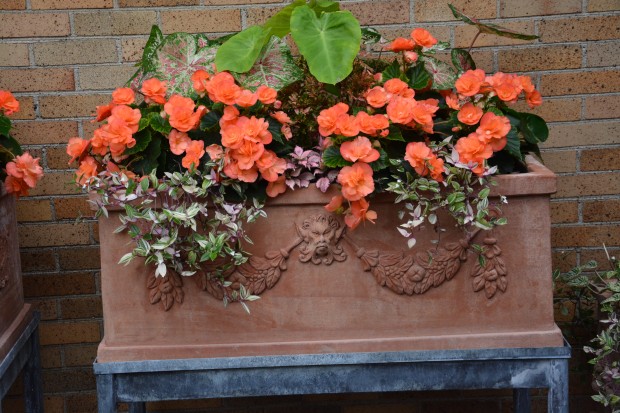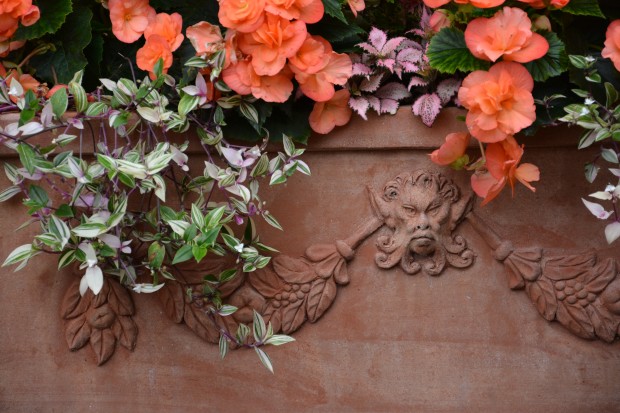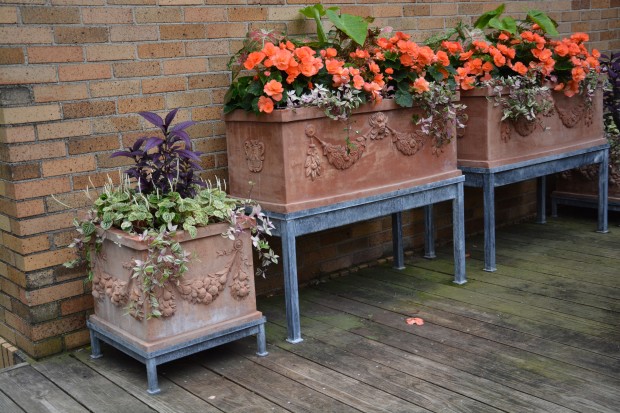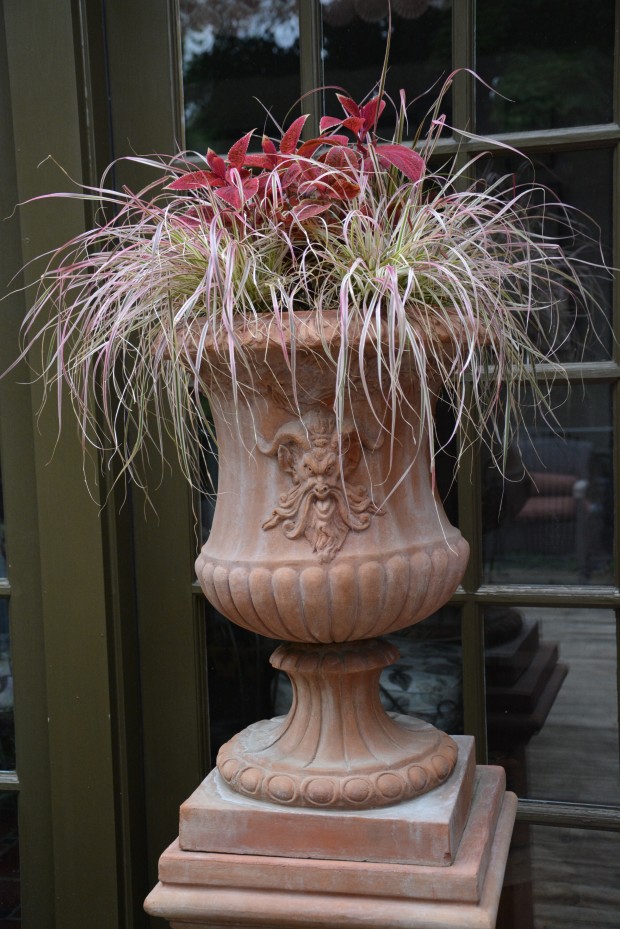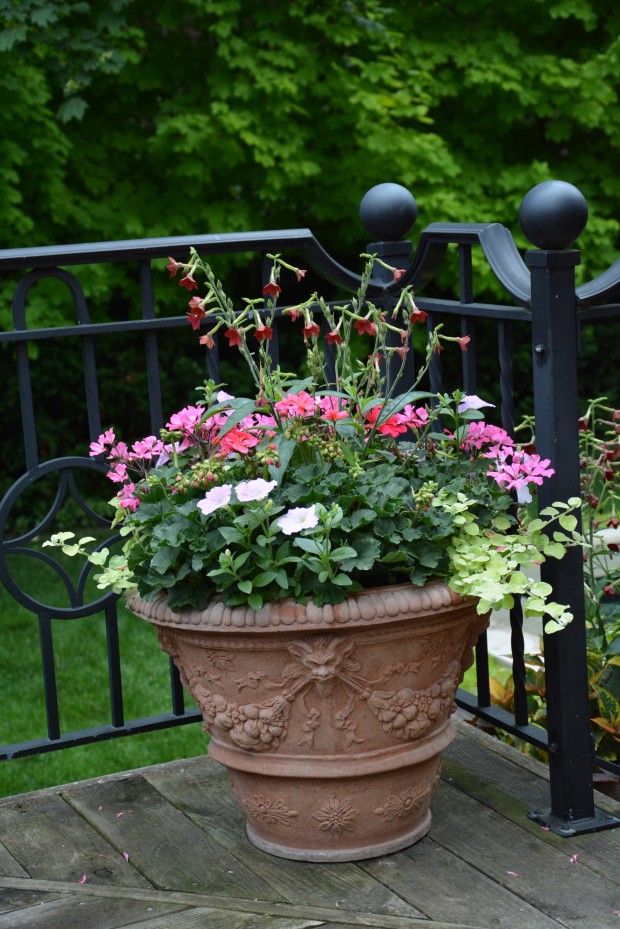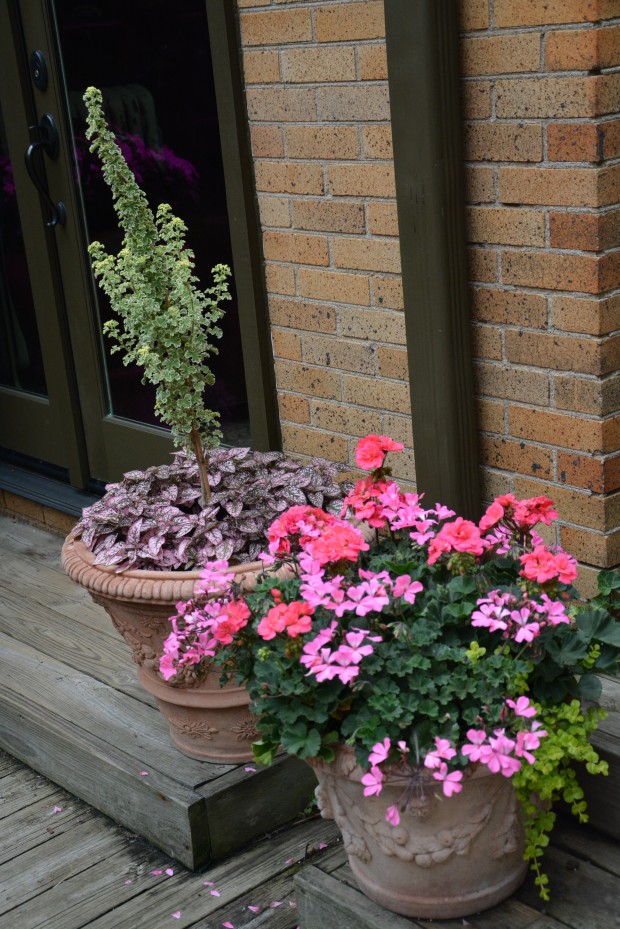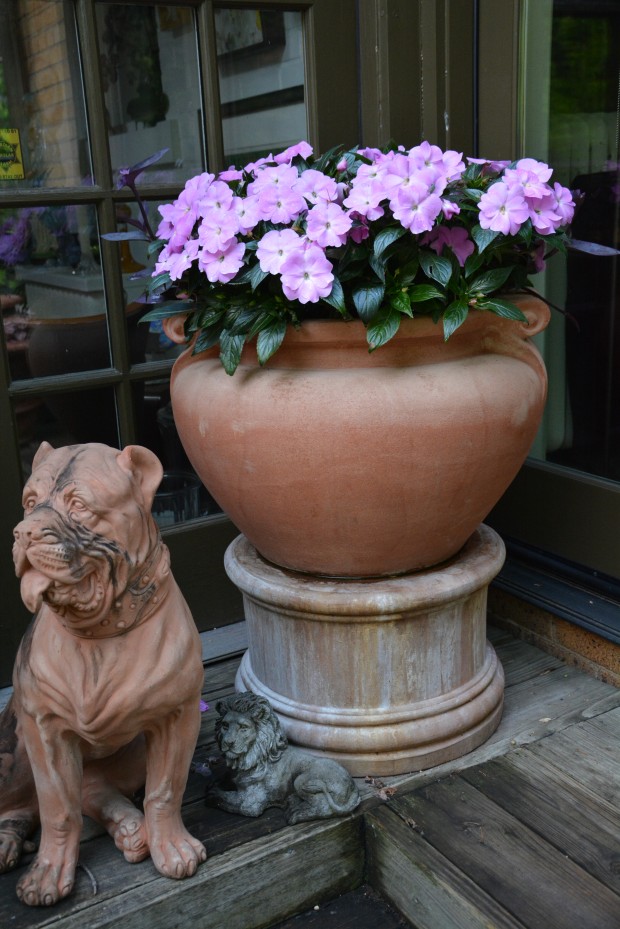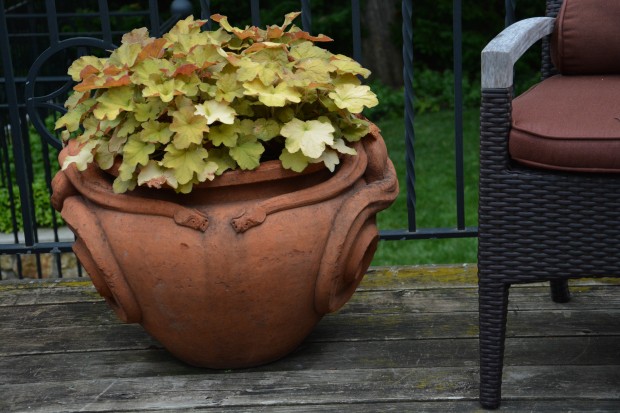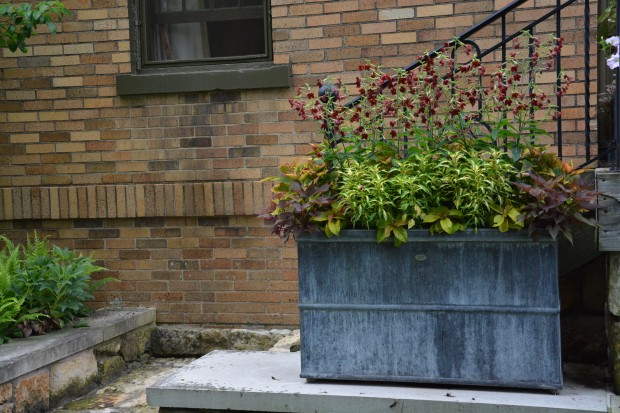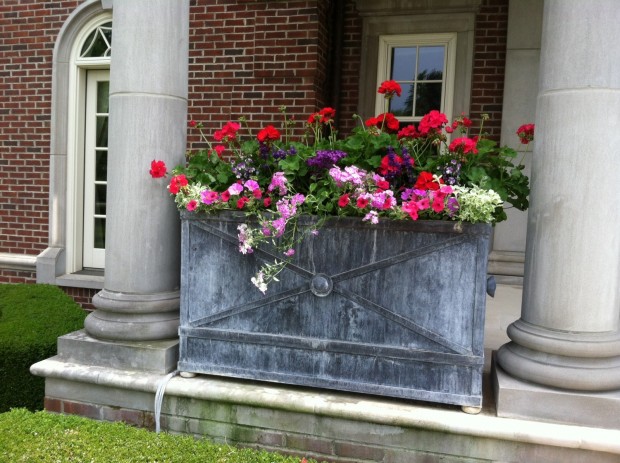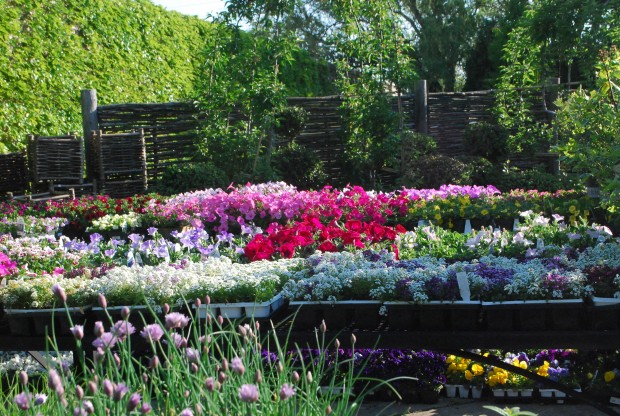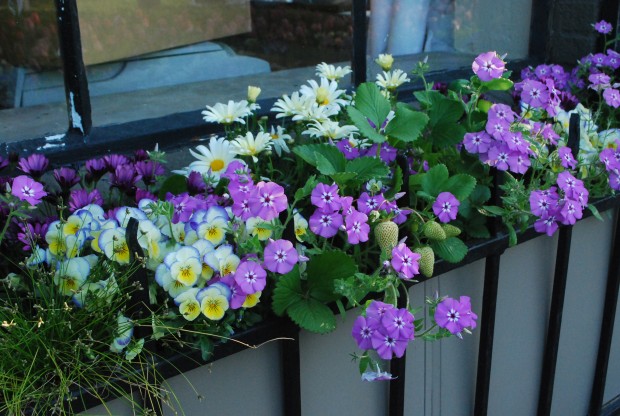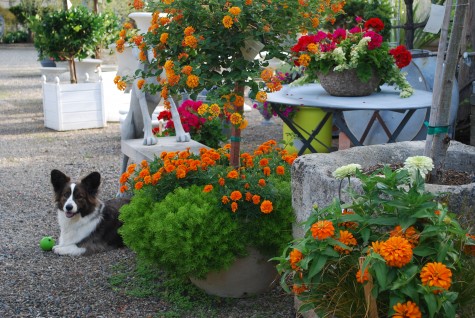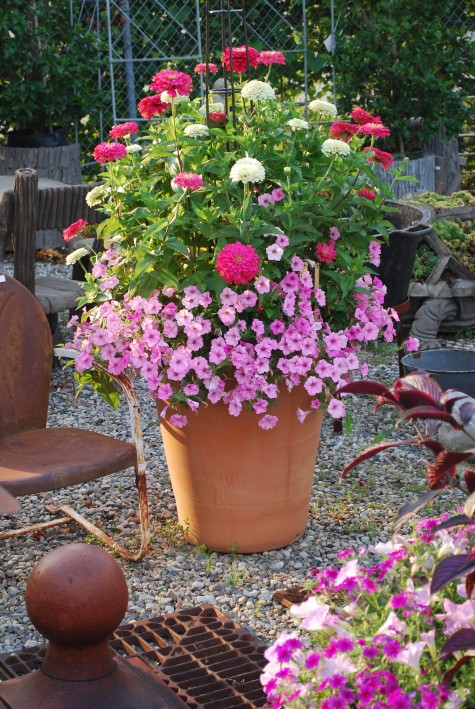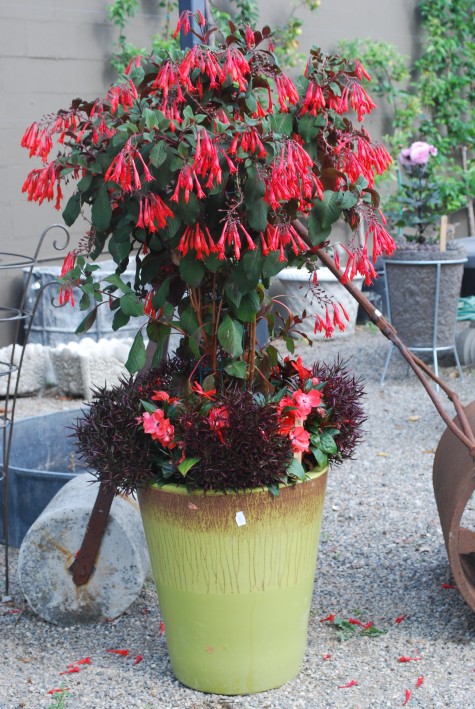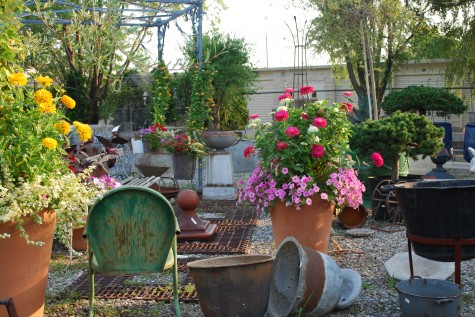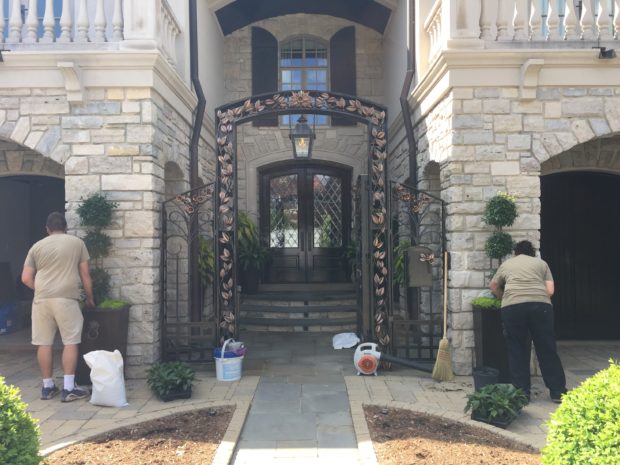 We are a good week or so into our container planting season. The location of the planters or the light and available water drives the selection of the plants. Sizing up the situation is key to successful container plantings. This pair of planters are tall and wide, as they needed to be, placed in front of substantial stone pillars. Their narrow depth is friendly to the fact that they are placed on a walkway. It is easy to see why my clients selected them. What plants did they ask for? These triple ball eugenia topiaries came in a 1 gallon pot. They would fit. Their shape addresses the formality of the entrance, and they add some much needed height and scale set against the mass of stone. Eugenias are also very tolerant of the shade cast by the north side of the house. There were at least 3 good reasons to plant them. When designing and choosing plants for containers, spend some time assessing your conditions.
We are a good week or so into our container planting season. The location of the planters or the light and available water drives the selection of the plants. Sizing up the situation is key to successful container plantings. This pair of planters are tall and wide, as they needed to be, placed in front of substantial stone pillars. Their narrow depth is friendly to the fact that they are placed on a walkway. It is easy to see why my clients selected them. What plants did they ask for? These triple ball eugenia topiaries came in a 1 gallon pot. They would fit. Their shape addresses the formality of the entrance, and they add some much needed height and scale set against the mass of stone. Eugenias are also very tolerant of the shade cast by the north side of the house. There were at least 3 good reasons to plant them. When designing and choosing plants for containers, spend some time assessing your conditions. 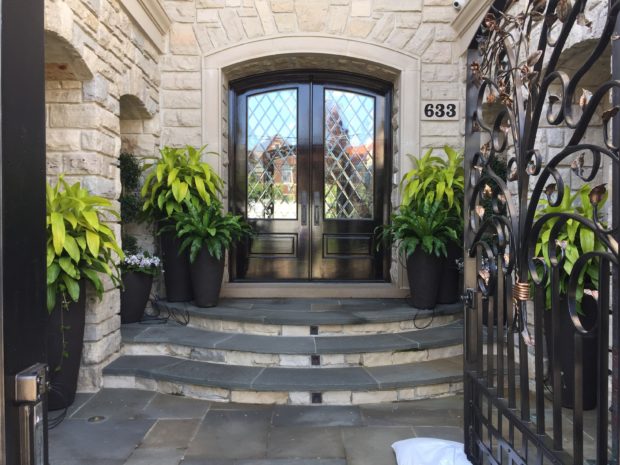 The interior of this front porch has a very high roof overhead. Add a northern exposure to the roof overhead means the shade here is serious shade. The porch is massive, and overscaled. Lots of stone and iron flank a pair of dark wood doors. This location asks for very shade tolerant plants with bold texture and good size that would soften and complement the architecture. The leaves of the lime dracaena “Janet Craig” will burn with the slightest exposure to sun. But in a place like this, they will thrive. The chartreuse leaves brighten the shade. They are striking in an architectural way.
The interior of this front porch has a very high roof overhead. Add a northern exposure to the roof overhead means the shade here is serious shade. The porch is massive, and overscaled. Lots of stone and iron flank a pair of dark wood doors. This location asks for very shade tolerant plants with bold texture and good size that would soften and complement the architecture. The leaves of the lime dracaena “Janet Craig” will burn with the slightest exposure to sun. But in a place like this, they will thrive. The chartreuse leaves brighten the shade. They are striking in an architectural way.
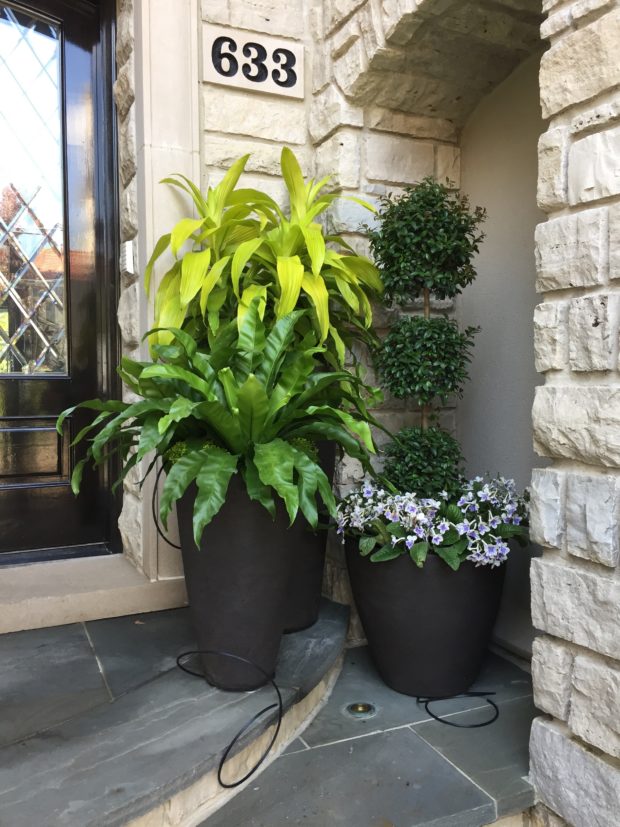 The purple and white flowering streptocarpus is a relative to African violets, and likewise thrives in low light. Given its diminutive size, it is most effective in a mass, as a supporting cast member in a container. The bird’s nest ferns are tropical, meaning they are not hardy in my zone. They offer big and strong mass, shape, and texture to a container planting, while asking for little in the way of light. The black tubes on the porch steps are irrigation lines which will provide water to the containers. No rain falls here given the roof, so all watering must be done mechanically, or by hand. We run the tubes through the bottom and out the top when we plant the pots as a courtesy to the irrigation contractor. Last but not least is the selection of the containers. They are of simple shape and smooth texture, which contrasts to the visual complexity of the stone, iron, and glass. The dark color echoes the dark wood doors, and visually defers to the plants.
The purple and white flowering streptocarpus is a relative to African violets, and likewise thrives in low light. Given its diminutive size, it is most effective in a mass, as a supporting cast member in a container. The bird’s nest ferns are tropical, meaning they are not hardy in my zone. They offer big and strong mass, shape, and texture to a container planting, while asking for little in the way of light. The black tubes on the porch steps are irrigation lines which will provide water to the containers. No rain falls here given the roof, so all watering must be done mechanically, or by hand. We run the tubes through the bottom and out the top when we plant the pots as a courtesy to the irrigation contractor. Last but not least is the selection of the containers. They are of simple shape and smooth texture, which contrasts to the visual complexity of the stone, iron, and glass. The dark color echoes the dark wood doors, and visually defers to the plants.
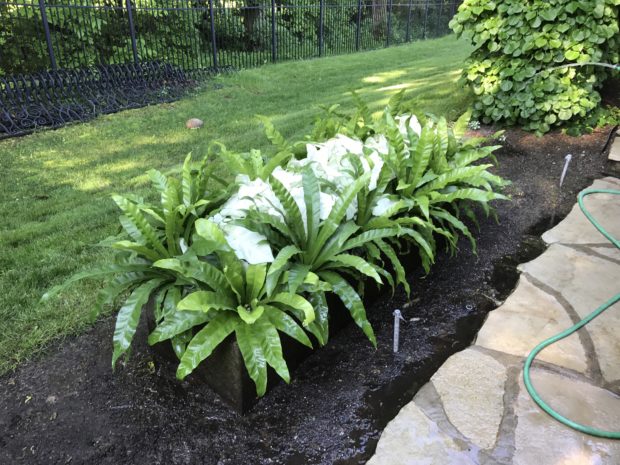 This deeply shaded and constantly wet spot was the perfect place for a large scale container. Everything that ever got planted in this ground promptly drowned. The caladiums and ferns tolerate the the shade, and their striking texture and color help to keep all eyes off the soggy dirt. I have on occasion planted sanseverias in the dirt. They never looked entirely happy, nor did they grow, but they lived. A container is a great idea for a place where nothing else wants to grow. Consider containers for those stubbornly bare spots. A soil and drainage structure above ground can circumvent poor conditions.
This deeply shaded and constantly wet spot was the perfect place for a large scale container. Everything that ever got planted in this ground promptly drowned. The caladiums and ferns tolerate the the shade, and their striking texture and color help to keep all eyes off the soggy dirt. I have on occasion planted sanseverias in the dirt. They never looked entirely happy, nor did they grow, but they lived. A container is a great idea for a place where nothing else wants to grow. Consider containers for those stubbornly bare spots. A soil and drainage structure above ground can circumvent poor conditions.
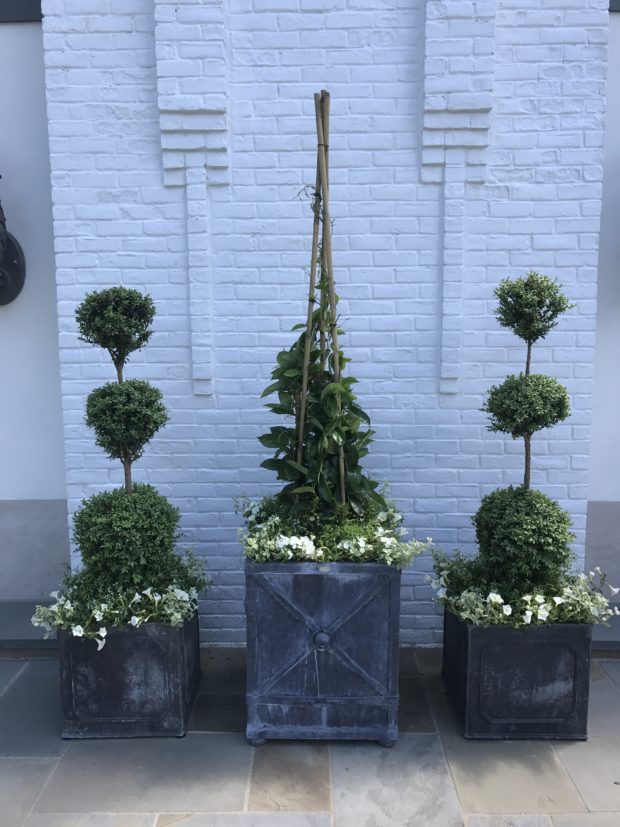 This painted brick chimney features a very interesting brick applique, quite unlike any I have ever seen. It thus asks for an arrangement of containers and plants that will not obstruct a view of that feature. The green and white under plantings emphasize that white brick. The triple ball Green Mountain boxwood topiaries can be planted in the ground for the winter, and will only get better with age. I would guess that these boxwood topiaries would would be fine in these lead pots for a number of years. The white mandevillea will loosen up the look a little, although I will advise my client to clip every once in a while.
This painted brick chimney features a very interesting brick applique, quite unlike any I have ever seen. It thus asks for an arrangement of containers and plants that will not obstruct a view of that feature. The green and white under plantings emphasize that white brick. The triple ball Green Mountain boxwood topiaries can be planted in the ground for the winter, and will only get better with age. I would guess that these boxwood topiaries would would be fine in these lead pots for a number of years. The white mandevillea will loosen up the look a little, although I will advise my client to clip every once in a while.
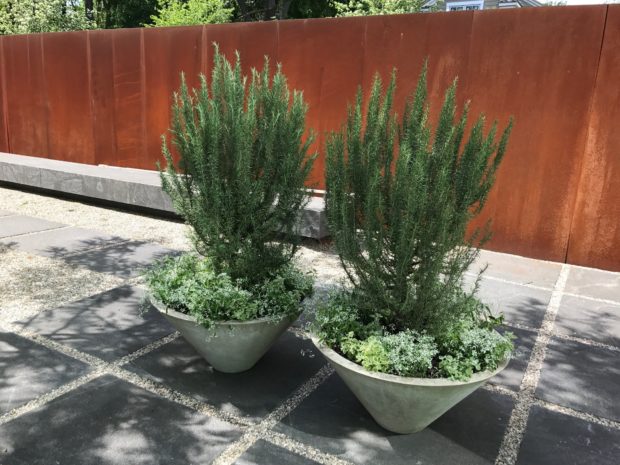 This contemporary landscape is dominated by a long and tall corten steel wall. Both the steel and the stone will absorb a lot of heat. The mid century modern pots are mid sized at the top, and small sized at the bottom. This situation calls for drought resistant plants. As for style, the wild and rangy rosemarys are good against the geometry established by the wall, bench, and terrace. The wide growing small felted leaves of the variegated licorice, and the cloud of tiny blooms from the euphorbia at the bottom will soften the look, without obscuring the shape of the planters.
This contemporary landscape is dominated by a long and tall corten steel wall. Both the steel and the stone will absorb a lot of heat. The mid century modern pots are mid sized at the top, and small sized at the bottom. This situation calls for drought resistant plants. As for style, the wild and rangy rosemarys are good against the geometry established by the wall, bench, and terrace. The wide growing small felted leaves of the variegated licorice, and the cloud of tiny blooms from the euphorbia at the bottom will soften the look, without obscuring the shape of the planters.
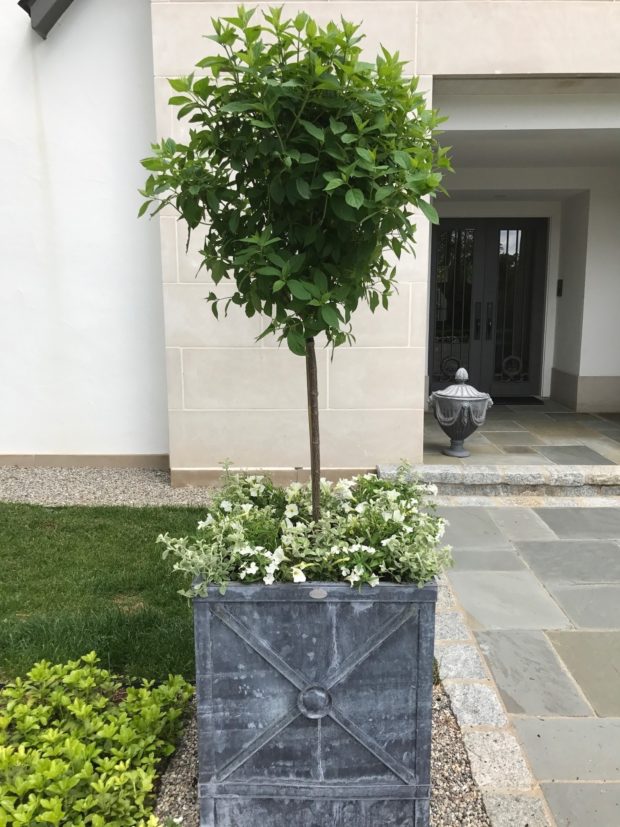 A container all on its own, well away from a porch or wall, asks for some volume and mass. Once this Limelight hydrangea topiary grows out and blooms, this 24″ by 24″ container will have a living tall and wide presence. The petunias, white phlox and variegated licorice will provide a wide and soft cushion below, in contrast to those big coarse hydrangea leaves. As the container is 30″ tall, there is room for the roots of a shrub to go deeper than the typical annual plant. The grass, ground cover, gravel, and stone are all on the same level-the ground plane. A tall container and a statuesque central and defining plant that represents the landscape on an entirely different level is particularly effective. Formal landscapes ask for equally formal container plantings.
A container all on its own, well away from a porch or wall, asks for some volume and mass. Once this Limelight hydrangea topiary grows out and blooms, this 24″ by 24″ container will have a living tall and wide presence. The petunias, white phlox and variegated licorice will provide a wide and soft cushion below, in contrast to those big coarse hydrangea leaves. As the container is 30″ tall, there is room for the roots of a shrub to go deeper than the typical annual plant. The grass, ground cover, gravel, and stone are all on the same level-the ground plane. A tall container and a statuesque central and defining plant that represents the landscape on an entirely different level is particularly effective. Formal landscapes ask for equally formal container plantings.
 This client owns a pair of particularly fine and detailed bronze urns. The recent planting was designed to never obstruct or impinge on the view of the urns. The white mandevillea will grow up, and provide some green company to the porch columns. The white sunpatiens will flush out, and grow wide.
This client owns a pair of particularly fine and detailed bronze urns. The recent planting was designed to never obstruct or impinge on the view of the urns. The white mandevillea will grow up, and provide some green company to the porch columns. The white sunpatiens will flush out, and grow wide.
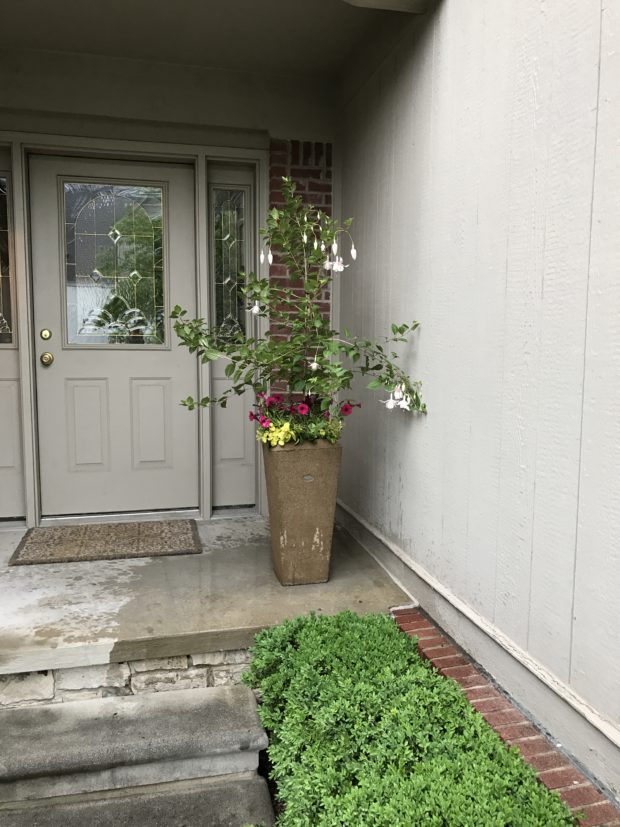 This small front porch does have a roof, but it does face south. This tall pot has a very small planting area. A tree form fuchsia with long and graceful arms readily fits in the small space. The petunias and licorice will not thrive to the extent they do in full sun-but in this situation, restrained growth will be good.
This small front porch does have a roof, but it does face south. This tall pot has a very small planting area. A tree form fuchsia with long and graceful arms readily fits in the small space. The petunias and licorice will not thrive to the extent they do in full sun-but in this situation, restrained growth will be good.
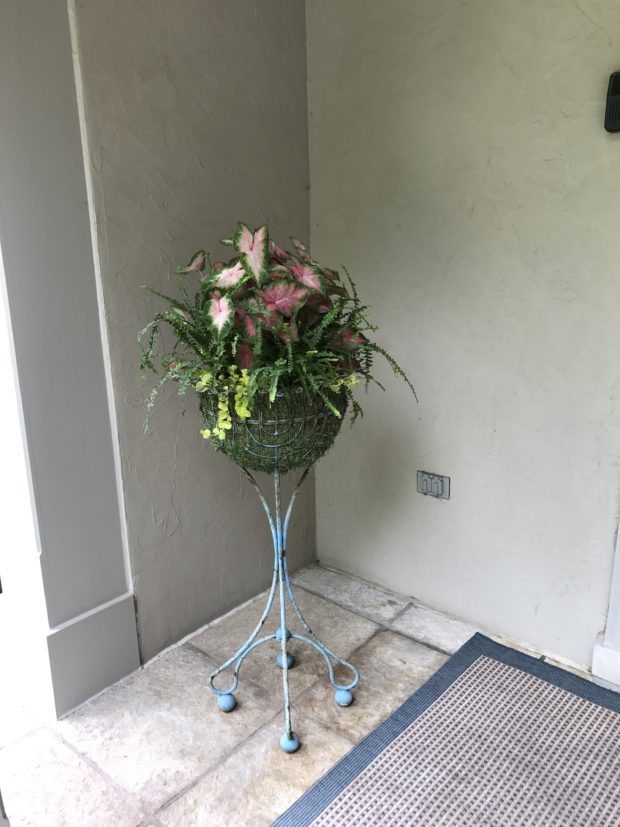 This delicate wire planter on legs is also placed on a covered porch, facing east. The pink caladiums will flush out, as will the button ferns. This will soften the blocky look of the walls and floor. The container is light enough to be taken out for some overhead light once in a while. The creeping jenny will cascade. A little judicious pruning will help keep that jenny narrow.
This delicate wire planter on legs is also placed on a covered porch, facing east. The pink caladiums will flush out, as will the button ferns. This will soften the blocky look of the walls and floor. The container is light enough to be taken out for some overhead light once in a while. The creeping jenny will cascade. A little judicious pruning will help keep that jenny narrow.
 These large Italian terra cotta pots occupy a partly shady corner on a terrace that occupies most of the floor space. Small beds permitted the planting of Boston ivy, and climbing roses, but containers provide an opportunity to really warm up the space. The fuchsias will bloom all summer in this protected location, as will the sunpatiens. These containers were planted on May 9 for an event on May 12. There would be no time for growing. So we planted gallon pots and baskets rather than 4″ pots. This is an equally good strategy if you need to plant seasonal containers late. Many greenhouse 2 or 3 crops a season, or an edited selection of annual plants in 6″ or 8″ pots. A new terrace, a birthday gift of a pot, a new house, an engagement party-there are plenty of good reasons to plant late.
These large Italian terra cotta pots occupy a partly shady corner on a terrace that occupies most of the floor space. Small beds permitted the planting of Boston ivy, and climbing roses, but containers provide an opportunity to really warm up the space. The fuchsias will bloom all summer in this protected location, as will the sunpatiens. These containers were planted on May 9 for an event on May 12. There would be no time for growing. So we planted gallon pots and baskets rather than 4″ pots. This is an equally good strategy if you need to plant seasonal containers late. Many greenhouse 2 or 3 crops a season, or an edited selection of annual plants in 6″ or 8″ pots. A new terrace, a birthday gift of a pot, a new house, an engagement party-there are plenty of good reasons to plant late.
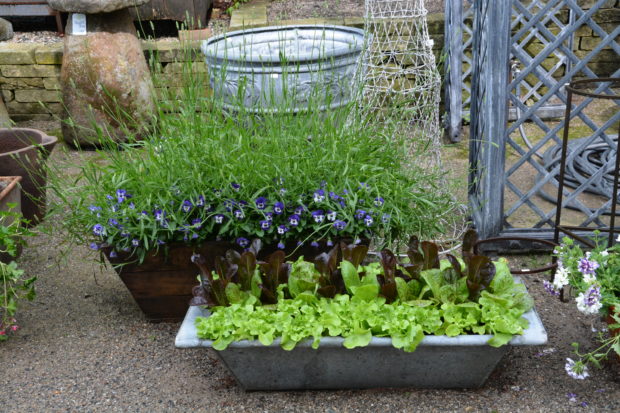 In the meantime, all of the containers we planted for spring look terrific right now. These plants are thriving in our cool weather. I like to plant seasonally. By this I mean the best place for heat loving annuals right now in my zone is a greenhouse. Deciding when to plant is an important decision. I will do most of my container plantings in the next 3 weeks.
In the meantime, all of the containers we planted for spring look terrific right now. These plants are thriving in our cool weather. I like to plant seasonally. By this I mean the best place for heat loving annuals right now in my zone is a greenhouse. Deciding when to plant is an important decision. I will do most of my container plantings in the next 3 weeks.
 Rob placed this basket full of white gerbera daisies next to this antique stone cistern. I think he did a great job of sizing up this situation.
Rob placed this basket full of white gerbera daisies next to this antique stone cistern. I think he did a great job of sizing up this situation.


